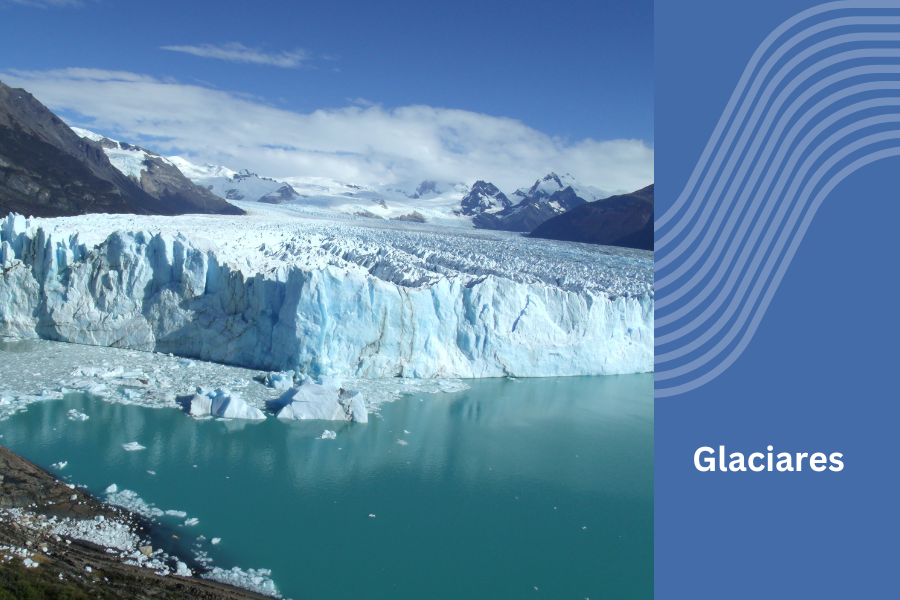The vast and remote region of Patagonia, shared by Argentina and Chile, is a true paradise for nature lovers. With its majestic mountains, breathtaking forests and vast, untouched landscapes, this land of contrasts offers an unparalleled experience. But it is Patagonia’s glaciers that cast a spell over visitors and impress them with their icy splendor.
Perito Moreno: an eternal blue giant
The Perito Moreno Glacier, located in the Los Glaciares National Park in the Argentinian province of Santa Cruz, is undoubtedly the undisputed star of Patagonia. With an ice front around 5 kilometers wide and an average height of 60 meters above sea level, this colossal glacier is one of the few in the world that is constantly advancing.
What makes the Perito Moreno so special is its cyclical behavior. From time to time, the glacier advances until it completely blocks the Rico arm of Lago Argentino and forms a natural freshwater dam. As soon as the water pressure reaches a critical point, the ice walls give way and an impressive natural spectacle occurs: the famous “glacier break”.
Witnessing this phenomenon is an experience beyond imagination. The deafening roar of the masses of ice weighing tons crashing into the turquoise waters of the lake remains in the memory of every visitor. It is a vivid reminder of the relentless power of nature and the fragility of our environment.
The ice explorers: trekking on glaciers
For the adventurous, Patagonia offers the unique opportunity to hike on the surface of these ice giants. Several companies offer glacier trekking excursions where visitors, equipped with crampons and climbing harnesses, can explore the crevasses, caves and millennia-old ice formations up close.
One of the most popular experiences is trekking on the Viedma Glacier, an impressive ice field covering more than 1,000 square kilometers. Here, adventurers can immerse themselves in a world of mesmerizing blue, crossing snow bridges and descending through deep crevasses while enjoying breathtaking panoramic views of the surrounding towering mountains.
The underwater world of the glaciers
But Patagonia’s glaciers are not just a spectacle on the surface. Hidden beneath the ice masses is an equally fascinating underwater world. The melting water of the glaciers feeds rivers, lakes and lagoons of an intense turquoise-blue color and creates landscapes that look like something out of a fairy tale.
One of the most exciting experiences is exploring these crystal-clear waters on board kayaks or inflatable boats. Gliding between whimsically shaped icebergs and through waters of unparalleled clarity, visitors can immerse themselves in a truly surreal and untouched environment.
Beyond the big names
Perito Moreno and Viedma are undoubtedly the most famous glaciers in Patagonia, but the region is home to a host of other equally impressive ice giants. From the imposing Upsala Glacier, one of the largest glaciers in South America, to the Spegazzini Glacier, whose deep blue ice walls rise majestically above the Canal de los Témpanos, each Patagonian glacier has its own unique beauty.
Defenders of climate protection
Apart from their breathtaking aesthetic beauty, Patagonia’s glaciers play a crucial role in understanding and monitoring global climate change. These ice giants are sensitive indicators of changing temperatures and weather patterns and provide invaluable information to scientists.
As glaciers melt and retreat, they expose evidence of past climates, such as rocks and sediments that have been trapped over thousands of years. Studying these geological clues can help researchers reconstruct past climate cycles and better predict the effects of global warming on our planet.
A precious resource in danger
Like many other glaciers around the world, Patagonia’s glaciers are unfortunately under existential threat from climate change. Rising global temperatures and changing precipitation patterns are accelerating their retreat, endangering not only these majestic landscapes but also the unique ecosystems that depend on them.
We must take urgent action to protect these natural wonders before it is too late. Reducing our greenhouse gas emissions, promoting sustainable practices and educating future generations about the importance of protecting our environment are crucial steps to ensure that Patagonia’s glaciers remain a living testament to the beauty and power of nature.
Conclusion
The glaciers of Patagonia are true natural treasures that need to be cared for and protected. From the imposing Perito Moreno to the lesser-known but equally impressive glaciers, each of these ice giants tells a unique story about our planet and its fragile balance. Exploring these icy landscapes is not only an unforgettable experience, but also a reminder of the urgent need to preserve these majestic sentinels of climate change for future generations.

